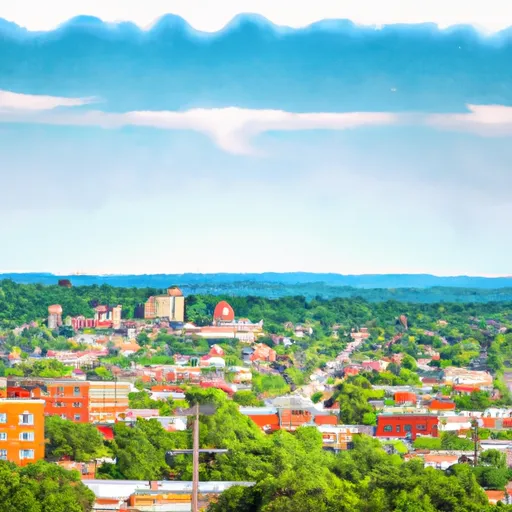-
 Snoflo Premium
Snoflo Premium
Get unlimited access to all our content
With no Ad interruptions! - Start Your Free Trial Login with existing account
Kingston
Eden Index
Climate
8.0
•
Recreation
5.2
•
Community
•
Safeguard
5.0/10

Kingston, Arkansas is a small town located in the Ozark Mountains region, renowned for its scenic beauty and outdoor recreation opportunities. The climate in Kingston is generally mild, with hot summers and cool winters. The area experiences abundant rainfall throughout the year, contributing to its lush greenery and vibrant ecosystem.
Hydrologically, Kingston is surrounded by natural springs, rivers, and creeks. The Buffalo National River, one of the few remaining undammed rivers in the country, flows nearby, offering opportunities for kayaking, canoeing, and fishing. The region is also dotted with pristine lakes, including Beaver Lake and Table Rock Lake, providing ample options for boating, swimming, and other water-based activities.
Outdoor enthusiasts will find an array of recreational opportunities in Kingston. Hiking trails crisscross the area, allowing visitors to explore the breathtaking landscapes and take in panoramic views. The Ozark National Forest, located nearby, offers opportunities for camping, rock climbing, and wildlife observation. Additionally, the region is a popular destination for hunting, with abundant game including deer, turkey, and small game species.
Overall, Kingston, Arkansas is a nature lover's paradise, offering a diverse range of activities and natural wonders to explore.
What is the Eden Index?
The Snoflo Eden Index serves as a comprehensive rating system for regions, evaluating their desirability through a holistic assessment of climate health, outdoor recreation opportunities, and natural disaster risk, acknowledging the profound impact of these factors on livability and well-being.
Climate Health Indicator (CHI): 8.0
Kingston receives approximately
1266mm of rain per year,
with humidity levels near 81%
and air temperatures averaging around
15°C.
Kingston has a plant hardyness factor of
7, meaning
plants and agriculture in this region tend to thrive during the non-winter months.
By considering the ideal temperature range, reliable water supplies, clean air, and stable seasonal rain or snowpacks, the Climate Health Indicator (CHI) underscores the significance of a healthy climate as the foundation for quality living.
A healthy climate is paramount for ensuring a high quality of life and livability in a region, fostering both physical well-being and environmental harmony. This can be characterized by ideal temperatures, reliable access to water supplies, clean air, and consistent seasonal rain or snowpacks.
Weather Forecast
Streamflow Conditions
Upper White
Area Rivers
Upper White
Snowpack Depths
Upper White
Reservoir Storage Capacity
Upper White
Groundwater Levels
Recreational Opportunity Index (ROI): 5.2
The Recreational Opportunity Index (ROI) recognizes the value of outdoor recreational options, such as parks, hiking trails, camping sites, and fishing spots, while acknowledging that climate plays a pivotal role in ensuring the comfort and consistency of these experiences.
Access to outdoor recreational opportunities, encompassing activities such as parks, hiking, camping, and fishing, is crucial for overall well-being, and the climate plays a pivotal role in enabling and enhancing these experiences, ensuring that individuals can engage in nature-based activities comfortably and consistently.
Camping Areas
| Campground | Campsites | Reservations | Toilets | Showers | Elevation |
|---|---|---|---|---|---|
| Ivan Lake | 4 | 212 ft | |||
| Frank Anthony RV Park | 30 | 242 ft | |||
| Harmon Lake Dam - Barksdale AFB | 6 | 222 ft | |||
| Highway 157 Primitive | None | 203 ft | |||
| Cypress Black Bayou Rec Area | None | 207 ft | |||
| Teague Lake Primitive | None | 199 ft | |||
| Barksdale AFB Military | None | 160 ft | |||
| Lake Bistineau State Park | None | 170 ft | |||
| South Abutment East | 12 | 177 ft | |||
| Turtle Slide | None | 223 ft |
Nearby Ski Areas
Catastrophe Safeguard Index (CSI):
The Catastrophe Safeguard Index (CSI) recognizes that natural disaster risk, encompassing floods, fires, hurricanes, and tornadoes, can drastically affect safety and the overall appeal of an area.
The level of natural disaster risk in a region significantly affects safety and the overall livability, with climate change amplifying these risks by potentially increasing the frequency and intensity of events like floods, fires, hurricanes, and tornadoes, thereby posing substantial challenges to community resilience and well-being.
Community Resilience Indicator (CRI):
The Community Resilience Indicator (CRI) recognizes that education, healthcare, and socioeconomics are crucial to the well-being of a region. The CRI acknowledges the profound impact of these elements on residents' overall quality of life. By evaluating educational resources, healthcare accessibility, and economic inclusivity, the index captures the essential aspects that contribute to a thriving community, fostering resident satisfaction, equity, and social cohesion.

